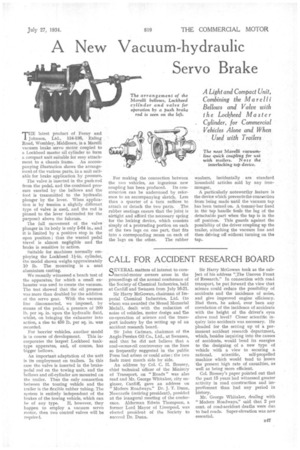A New Vacuum-hydraulic Servo Brake
Page 65

If you've noticed an error in this article please click here to report it so we can fix it.
THE latest product of Feeny and Johnson, Ltd., 134-186, Ealing . Road, Wembley, Middlesex, is a Marelli vacuum brake servo motor coupled to a Lockheed master oil cylinder to form a compact unit suitable for easy attachment to a chassis frame. An accompanying illustration shows the arrangement of the various parts, in a unit suit
able for brake application by pressure. The valve is inserted in the push-rod from the pedal, and the combined pres sure exerted by the bellows and the foot is transmitted to the hydraulic plunger by the lever. When applica tion is by tension a slightly different type of valve is used, and the rod is pinned to the lever (extended for the purpose) above the fulcrum.
The full movement of the valve plunger in its body is only 5-64 in., and it is limited by a positive stop in the open position ; thus the wasted pedal travel is almost negligible and tha brake is sensitive in action.
Suitable for machines normally employing the Lockheed 1i-in. cylinder, the model shown weighs approximately 10 lb. The mounting is a neat aluminium casting.
We recently witnessed a bench test of the apparatus, for which a small ex hauster was. used to create the vacuum.
The test showed that the oil pressure was more than doubled by the addition of the servo gear. With the vacuum line disconnected, we imposed, by means of the pedal, a pressure of 200 lb. per sq. in. upon the hydraulic fluid, whilst, on bringing the exhauster into action, a rise to 450 lb. per sq. in. was recorded.
For heavier vehicles, another model is in course of development. This in corporates the largest Lockheed tanktype apparatus, and, of course, has bigger bellows..
An important adaptation of the unit is its employment on trailers. In this case the valve is inserted in the brake pedal rod on the towing unit, and the bellows and oil-cylinder are mounted en the trailer. Thus the only connection between the touring vehicle and the trailer is the flexible rubber tubing. The system is entirely independent of the brakes of the towing vehicle, which can be of any type. If, however, they happen to employ a vacuum servo motor, then two control valves will be required. For making the connection between the two vehicles, an ingenious new coupling has been produced. Its con• struction can be understood by reference to an accompanying sketch. Less than a quarter of a turn suffices to attach or detach the two parts. The rubber seatings ensure that the joint is airtight and afford the necessary spring for the locking device, which consists simply of a protruding portion on each of the two lugs on one part, that fits into a corresponding recess on each of the lugs on the other. The rubber washers, incidentally are standard household articles sold by any ironmonger., A particularly noteworthy feature is the device which prevents the connection from being made until the vacuum tap has been turned on. A tommy-bar fixed in the tap handle fouls the lug of the detachable part when the tap is in the off position. This guards against the possibility of the driver coupling up the trailer, attaching the vacuum line and then driving off without turning on the tap..




































































































